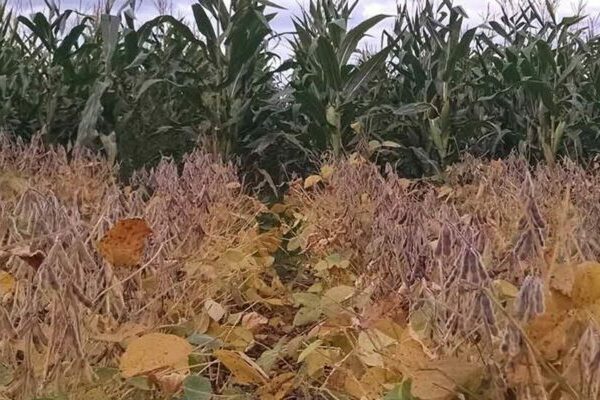Sudden death syndrome (SDS) is a devastating disease that afflicts soybean crops, causing annual losses in U.S. soybean yields in excess of $274 million dollars. New Michigan State University research shows that the trick to surviving the disease might be a matter of timing when to mount a defense response.
The new study compares how the fungus F. virguliforme, which causes SDS, interacts with both soybean and maize crops and examines why maize remain healthy despite fungal invasion. The study is published in the journal The Plant Cell.
“Maize and soybean are often rotated on the same land to prevent SDS from spreading. But this farming strategy does not stop soybeans from getting sick from the fungus,” says Amy Baetsen-Young, a former PhD student in the lab of MSU Foundation Professor Dr. Brad Day. ”We used this observation as our starting point to look for genes that allow maize to show no disease symptoms to the same fungus that debilitates soybeans.”
“Our major finding is that, although fungus also invades maize, the maize reacts very early, which leads to a robust defense response and a better chance of staying healthy,” says Huan Chen, a second year graduate student in the Molecular Plant Sciences graduate program.
BEATING FUNGI TO THE CLOCK
The research team took a big data approach to compare if and how maize and soybean mount their defense responses when facing off against the fungus.
It turns out that when the crop mounts a defense response is crucial to maintaining health, and earlier is better. Soybean defenses ramp up seven days after the onset of the fungal invasion, at which point the fungus is in damage mode. In contrast, maize defenses kick in two days after invasion, which slows down the growth of the fungus before it turns damaging.
“Our data also suggest that the fungus is associated with senescence in soybeans, a natural process where cells grow old and die,” Huan says. “Although we see senescence in infected soybean, we are not sure if the fungus triggers the soybean to ‘grow old’ so that the fungus can grow and develop, or if senescence is simply a symptom that appears as the disease develops.”
The research team also shows that fungal infestation triggers different genetic responses in both crops. There is even a hint that the fungus might manipulate their hosts’ metabolism in order to cause cell death.
“SDS is a disease that cannot be fully managed, which is why we need to understand it better,” Huan says. “Moreover, some fungi invade a broad range of important crops, and not all plants react in the same way to attacks from other microbes, as we show here. Our computational biology and big data approaches could help yield a big picture view of disease progression and prevention.”
“This study represents an example of integrating disciplines – from genes to cropping systems – and the complementarity of academic expertise,” says Brad. “Amy’s PhD work has established a new foundation, and a high bar, from which we can begin to address fully-integrated computation approaches into important field-based questions. The collaboration between students, together with Dr. Shin-Han Shiu at MSU, illustrates the ability of teams to move knowledge forward and address significant gaps in fundamental biology and applied agriculture.”
Read the paper: The Plant Cell
Article source: Michigan State University
Author: Igor Houwat, Huan Chen, Amy Baetsen-Young, Brad Day
Image: Senescing soybeans. Credit: Amy Baetsen-Young








